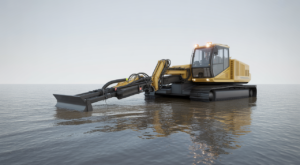Transform Waterway Maintenance With Hydraulic Dredging Equipment

Maintaining waterways is a critical task for ensuring navigable, safe, and healthy aquatic environments. Waterways, such as rivers, lakes, harbors, and canals, require regular maintenance to prevent issues like sediment accumulation, which can lead to navigational hazards, flooding, and environmental degradation. Hydraulic dredging equipment has emerged as a transformative solution for efficient and effective waterway maintenance. This technology utilizes the power of water to remove and relocate sediments, offering numerous benefits over traditional dredging methods. In this article, we will explore the basics, advantages, types, environmental impacts, operational efficiencies, cost-effectiveness, and future innovations of hydraulic dredging equipment in waterway maintenance.
Understanding The Basics Of Hydraulic Dredging Equipment For Waterway Maintenance
Hydraulic dredging equipment operates on the principle of using water to excavate and transport sediments from the bottom of water bodies. The process involves a dredge pump, suction pipe, and discharge pipeline. The dredge pump creates a vacuum that sucks up sediments, which are then mixed with water to form a slurry. This slurry is transported through the suction pipe to the discharge pipeline, where it can be deposited in designated areas such as spoil sites or sediment basins. The equipment comes in various sizes and configurations, including cutter suction dredges, hopper dredges, and plain suction dredges, each suited for specific types of waterway maintenance tasks. Hydraulic dredging is particularly effective in dealing with fine sediments like silt and clay, making it ideal for maintaining waterways with such materials. By understanding the basics of how this equipment works, waterway managers can make informed decisions about its application in their maintenance projects.

Advantages Of Using Hydraulic Dredging Equipment In Waterway Maintenance
One of the primary advantages of hydraulic dredging equipment is its ability to handle large volumes of sediment efficiently. Traditional mechanical dredging methods, such as clamshell dredging, can be labor-intensive and time-consuming. In contrast, hydraulic dredging can continuously pump sediment, allowing for more rapid removal and relocation. This continuous operation reduces downtime and increases the overall productivity of maintenance projects. Additionally, hydraulic dredging minimizes the resuspension of sediments compared to mechanical methods, which often disturb the bottom material and release contaminants into the water column. This reduced turbidity is crucial for maintaining water quality and protecting aquatic habitats. Another significant advantage is the ability to precisely control the depth and location of sediment removal, ensuring that maintenance efforts are targeted and effective. These benefits collectively make hydraulic dredging a preferred choice for many waterway maintenance projects.
Hydraulic Dredging Equipment And Their Applications In Waterway Maintenance
Hydraulic dredging equipment comes in several types, each designed for specific applications and environments. Cutter suction dredges (CSD) are among the most common types, featuring a rotating cutter head that loosens the sediment before suctioning it up. CSDs are ideal for hard or compacted sediments and are widely used in river and harbor maintenance. Hopper dredges are another type, characterized by their ability to store dredged material onboard before transporting it to a disposal site. These dredges are particularly useful for maintaining navigational channels and port areas where frequent dredging is required. Plain suction dredges, which lack a cutter head, are suitable for loose, soft sediments and are often used in lakes and reservoirs. Each type of hydraulic dredging equipment has unique capabilities that make it suitable for different maintenance scenarios, enabling tailored solutions for various waterway challenges.
Benefits Of Hydraulic Dredging Equipment In Waterway Maintenance Projects
Hydraulic dredging equipment offers several environmental benefits that make it a sustainable choice for waterway maintenance. One of the most significant advantages is the reduced environmental impact compared to traditional dredging methods. Hydraulic dredging minimizes the disturbance of sediments, reducing the resuspension of contaminants and the release of harmful substances into the water column. This is particularly important in areas with sensitive ecosystems or polluted sediments. Additionally, hydraulic dredging allows for precise removal of sediments, which helps in maintaining aquatic habitats and preventing the destruction of critical areas such as fish spawning grounds. The ability to transport sediments over long distances through pipelines also reduces the need for transporting dredged material by truck or barge, further minimizing the environmental footprint of maintenance activities. These benefits contribute to the overall sustainability of waterway maintenance projects, making hydraulic dredging an environmentally friendly option.
How Hydraulic Dredging Equipment Transforms Waterway Maintenance?
Operational efficiency is a key factor in the success of waterway maintenance projects, and hydraulic dredging equipment excels in this area. The continuous operation of hydraulic dredges allows for uninterrupted sediment removal, significantly increasing the speed and efficiency of maintenance efforts. This is particularly beneficial for large-scale projects where time is a critical factor. Hydraulic dredging also enables precise control over the dredging process, allowing operators to target specific areas and depths with accuracy. This precision reduces the risk of over-dredging or under-dredging, ensuring that maintenance objectives are met effectively. Furthermore, the ability to handle a wide range of sediment types and conditions makes hydraulic dredging versatile and adaptable to various waterway environments. The combination of speed, precision, and versatility results in a highly efficient maintenance process that can save time and resources.
Cost Effectiveness Of Hydraulic Dredging Equipment In Long Term Waterway Maintenance
Cost-effectiveness is a crucial consideration for any maintenance project, and hydraulic dredging equipment offers significant advantages in this regard. The efficiency and speed of hydraulic dredging reduce the overall time required for maintenance activities, leading to lower labor and operational costs. The continuous operation of hydraulic dredges minimizes downtime, further enhancing cost savings. Additionally, the precise control over sediment removal reduces the likelihood of costly rework or additional maintenance efforts. The ability to transport dredged material over long distances through pipelines also eliminates the need for expensive transportation logistics. Over the long term, the durability and reliability of hydraulic dredging equipment contribute to reduced maintenance and replacement costs. These factors combined make hydraulic dredging a cost-effective solution for maintaining waterways, providing both immediate and long-term financial benefits.
Innovations In Hydraulic Dredging Equipment: Future Trends In Waterway Maintenance
The field of hydraulic dredging equipment is continually evolving, with new innovations and technologies enhancing its effectiveness and efficiency. One of the key trends is the development of more advanced automation and control systems. These systems enable real-time monitoring and adjustment of dredging operations, allowing for even greater precision and efficiency. Another significant trend is the integration of environmental sensors and monitoring tools, which help operators minimize environmental impacts and ensure compliance with regulatory requirements. Advances in materials and design are also leading to more durable and lightweight equipment, reducing operational costs and improving performance. Additionally, the use of renewable energy sources and eco-friendly materials is becoming increasingly common, further enhancing the sustainability of hydraulic dredging. These innovations are poised to transform waterway maintenance, making it more efficient, cost-effective, and environmentally friendly.
Conclusion
Hydraulic dredging equipment has revolutionized the field of waterway maintenance, offering numerous benefits over traditional methods. From its basic operation to its environmental advantages and cost-effectiveness, hydraulic dredging provides a comprehensive solution for maintaining navigable and healthy waterways. The various types of equipment available allow for tailored approaches to different maintenance challenges, while innovations continue to enhance its effectiveness and sustainability. As waterways face increasing pressures from sediment accumulation and environmental degradation, hydraulic dredging equipment will play a crucial role in ensuring their long-term health and functionality. By embracing this technology, waterway managers can achieve more efficient, effective, and sustainable maintenance outcomes.








